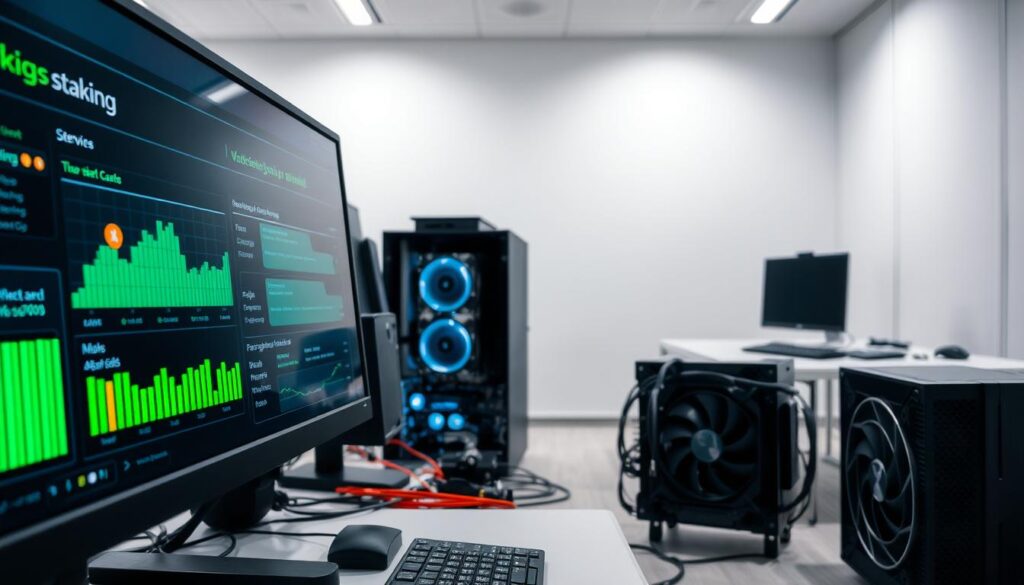Now Reading: What Are Blockchain Validators and How They Work Explained
- 01
What Are Blockchain Validators and How They Work Explained
What Are Blockchain Validators and How They Work Explained

Imagine a digital ledger that operates without a central bank or company in charge. This is the power of a blockchain network. To function correctly, these decentralized systems rely on special participants called validators.
These individuals or entities act as the guardians of the system. Their primary job involves verifying and confirming transactions. This process ensures every action follows the network’s strict rules.
Unlike traditional finance, no single authority has control. Validators are distributed across the globe. They collaborate to achieve consensus on the ledger’s state, preventing issues like double-spending.
This creates a trustless environment where security is maintained through collective effort. Understanding this role is crucial for exploring modern platforms like Ethereum and Solana. Validators are indispensable for maintaining integrity and security.
Key Takeaways
- Validators are critical participants responsible for verifying transactions on a blockchain.
- They help maintain network security and decentralization without a central authority.
- Validators achieve consensus to agree on the current state of the ledger.
- Their work prevents fraudulent activities, ensuring transaction accuracy.
- This role is fundamental to Proof-of-Stake and other modern blockchain systems.
- Understanding validators is key to grasping how decentralized networks operate.
Overview of Blockchain Validators
Blockchain networks rely on a unique class of participants who ensure the accuracy and security of every transaction recorded. These specialized nodes form the foundation of trust in decentralized systems.
Defining Blockchain Validators
A blockchain validator operates as a critical node within the network infrastructure. Their primary function involves verifying transactions according to established protocol rules.
In Proof-of-Stake systems, these participants stake cryptocurrency as collateral. This economic commitment ensures honest behavior while supporting network operations.
The validator role differs significantly from traditional mining approaches. Instead of solving complex puzzles, they’re selected based on staked holdings.
Historical Evolution and Emerging Trends
Blockchain technology has evolved from energy-intensive Proof-of-Work systems. Modern networks favor sustainable Proof-of-Stake consensus mechanisms.
Major platforms like Ethereum transitioned to reduce environmental impact. This shift addresses scalability concerns while maintaining security.
Emerging trends include delegated models and increased accessibility. Average users can now participate without specialized hardware requirements.
what are blockchain validators and how they work
Every cryptocurrency transfer requires authentication by network participants who ensure protocol compliance and fund availability. These specialized nodes perform essential duties that maintain ledger accuracy across decentralized systems.

Verifying Transactions and Maintaining Integrity
The validation process begins when new transactions enter the network. Participants check each transaction’s format against established rules.
They confirm senders possess sufficient funds before approving transfers. This prevents fraudulent activities like double-spending attempts.
After verification, these nodes bundle legitimate transactions into new blocks. They add these blocks to their local ledger copy, ensuring network-wide consistency.
Key Differences Between Validators and Miners
While both roles add blocks to the blockchain, their methods differ significantly. The table below highlights core distinctions:
| Feature | Miners | Validators |
|---|---|---|
| Consensus Mechanism | Proof-of-Work | Proof-of-Stake |
| Primary Requirement | Specialized hardware | Staked cryptocurrency |
| Energy Consumption | High | Low |
| Selection Process | Computational competition | Stake-based selection |
| Primary Rewards | Block rewards + fees | Transaction fees |
Miners prove commitment through energy expenditure, while validators demonstrate honesty through financial collateral. This fundamental difference shapes each network’s security model and environmental impact.
The Role of Validators in Ensuring Network Security
Cryptocurrency platforms achieve trustworthiness through distributed verification processes performed by dedicated nodes. These participants form the backbone of network security, protecting against various threats while maintaining system integrity.
Preventing Fraud and Double Spending
Validators meticulously examine each transaction to detect fraudulent activities. They verify digital signatures and fund availability before approving any transfer.
This distributed approach creates strong resistance to manipulation. Multiple independent validators must agree before blocks are added to the chain.

Participation in Consensus Mechanisms
These specialized nodes actively engage in consensus processes to reach collective agreement. Each validator contributes to voting mechanisms that determine valid blocks.
This distributed power makes 51% attacks extremely difficult and expensive. Malicious behavior results in penalties, including loss of staked assets, which helps manage crypto transaction fees efficiently.
| Security Aspect | Centralized Systems | Decentralized Validator Networks |
|---|---|---|
| Fraud Prevention | Single point of control | Distributed verification |
| Attack Resistance | Vulnerable to single failure | Requires compromising multiple nodes |
| Transaction Integrity | Dependent on central authority | Cryptographic verification by many |
| Incentive Structure | Centralized rewards | Stake-based penalties and rewards |
How to Become a Blockchain Validator
The path to becoming a validator involves technical setup and financial commitment to support network operations. This process allows individuals to actively participate in securing decentralized systems.
Setting Up Your Validator Node
Establishing a validator node begins with selecting a Proof-of-Stake blockchain platform. You’ll need to install specific client software on a reliable computer or server.
The configuration process requires careful attention to network settings and synchronization. Proper setup ensures your node can communicate effectively with other participants.

Platforms like Ethereum offer streamlined approaches through services like Ledger’s validator solutions. Their system guides users through account creation and software installation.
Staking Requirements and Crypto Collateral
Financial commitment forms the foundation of validator participation. Most networks require locking a specific amount of native tokens as collateral.
This stake serves as security against malicious behavior. Validators risk losing these funds if they violate network rules through penalties called slashing.
Research commitment terms carefully before staking your cryptocurrency. Some platforms offer partner services that simplify the process while providing predictable returns.
Understanding Consensus Mechanisms in Blockchain Networks
The backbone of every distributed ledger lies in its method for achieving agreement among participants. These consensus mechanisms determine how transactions get verified and added to the chain.
Different protocols create distinct environments for network participants. The choice of consensus mechanism impacts security, speed, and energy consumption.
Proof-of-Stake vs. Proof-of-Work
Proof work systems require miners to solve complex mathematical puzzles. This energy-intensive process secures networks like Bitcoin and Litecoin.
In contrast, proof stake selects validators based on their staked cryptocurrency. POS networks like Ethereum achieve consensus without massive computational power.
| Feature | Proof-of-Work | Proof-of-Stake |
|---|---|---|
| Energy Usage | Extremely High | Minimal |
| Participant Role | Miners | Validators |
| Security Model | Computational Power | Economic Stake |
| Example Networks | Bitcoin, Litecoin | Ethereum, Avalanche |
Advanced Models: DPoS, BFT, and More
Delegated proof stake (DPoS) uses elected delegates for validation. This approach enhances scalability in networks like EOS and Tron.
Byzantine Fault Tolerance (BFT) mechanisms ensure consensus despite malicious nodes. These systems prioritize rapid transaction processing.
Specialized consensus models continue evolving to address specific network needs. Each mechanism offers unique advantages for different blockchain networks.
Technical Setup and Staking Process
The technical setup for running a validator involves balancing system requirements with economic considerations. This process requires attention to both hardware specifications and financial commitment.
Hardware and Software Considerations
Setting up a validator node begins with selecting appropriate hardware. Unlike Proof-of-Work systems, Proof-of-Stake validation typically uses standard computer equipment.
Most networks require reliable internet connectivity and sufficient storage capacity. Some platforms like Shardeum enable participation with minimal hardware configuration.

Software installation involves blockchain client applications and proper configuration. Maintaining synchronization with the network ensures optimal performance.
Managing Transaction Fees and Rewards
Validators receive compensation for their work through transaction fees and block rewards. Honest participation earns cryptocurrency based on stake size.
The reward distribution process varies by network design. Some systems include newly minted coins alongside transaction fees.
Dishonest behavior triggers penalties including stake loss. This economic model encourages proper validation of all transactions.
| Reward Component | Source | Distribution Method |
|---|---|---|
| Transaction Fees | User payments | Proportional to stake |
| Block Rewards | Newly minted coins | Based on participation |
| Penalty System | Stake reduction | For malicious actions |
Enhancing Blockchain Integrity and Efficiency
The effectiveness of distributed ledger technology hinges on meticulous validator operations that uphold protocol standards. These participants play crucial roles in maintaining system integrity while improving overall performance.
Best Practices for Validator Operations
Successful validator functions require consistent uptime and robust security measures. Maintaining reliable node operation ensures continuous participation in consensus mechanisms.
Validator nodes must scrutinize every transaction within blocks for accuracy. They enforce cryptographic rules and size constraints to prevent malicious tampering.
Proper transaction sequencing establishes chronological accuracy across networks. This prevents double-spending issues while maintaining ledger integrity.
Following protocol rules precisely protects staked assets from penalties. Any deviation risks financial consequences and compromises network security.
Future Trends: Sharding and Layer 2 Solutions
Sharding technology partitions blockchains into smaller, manageable sections. This approach enables parallel processing by multiple validator groups.
Layer 2 solutions handle increased transaction volume off the main chain. These innovations significantly improve scalability while reducing congestion.
Ethereum’s transition to Proof-of-Stake demonstrated remarkable energy efficiency. The network achieved a 99.99% reduction in power consumption.
Future developments may lead to specialized validator roles focusing on specific functions. This specialization could further enhance blockchain performance across industries.
Conclusion
Distributed ledger technology achieves its revolutionary potential through the dedicated efforts of network participants who verify and secure every transaction. These individuals perform the critical blockchain validator role that maintains system integrity across decentralized networks.
Unlike traditional miners in Proof-of-Work systems, validators in proof stake networks use staked cryptocurrency as collateral. This approach creates powerful economic incentives for honest behavior while ensuring energy efficiency.
The security of these systems depends on validators meticulously checking each transaction against protocol rules. Their collective consensus building prevents fraud and maintains an immutable ledger without central authority.
As technology evolves with innovations like sharding, the blockchain validator role continues to adapt. These participants remain essential guardians of decentralization, ensuring transparent and reliable operations across all cryptocurrency platforms.
FAQ
What is the primary function of a validator in a blockchain network?
The main job of a validator is to check transactions and create new blocks. They ensure every transaction follows the network rules. This process keeps the system secure and trustworthy for everyone using it.
How does a validator differ from a traditional miner?
Miners, used in Proof-of-Work systems like Bitcoin, solve complex puzzles using powerful computers. Validators, common in Proof-of-Stake networks like Ethereum, are chosen to create blocks based on the amount of cryptocurrency they have staked as collateral. This shift improves energy efficiency and scalability.
What is staking, and why is it required to become a validator?
Staking means locking up a certain amount of a network’s native tokens. This stake acts as a security deposit. It incentivizes validators to act honestly. If they try to cheat the system, they risk losing their staked funds.
What are the risks involved in being a validator?
The main risk is “slashing,” where a portion of your staked tokens is taken away as a penalty for malicious actions or going offline. There is also market risk, as the value of your staked cryptocurrency can fluctuate.
How do validators earn rewards for their work?
Validators receive rewards from two main sources. They earn newly created tokens for adding new blocks to the chain. They also collect transaction fees paid by users for processing their transfers on the network.
Can anyone become a blockchain validator?
Technically, yes, but there are significant barriers. You need to meet the minimum staking requirement, which can be substantial. You also need the technical knowledge to set up and maintain a reliable validator node that stays online consistently.
What is the difference between Proof-of-Stake and Proof-of-Work consensus?
Proof-of-Work relies on computational power and energy consumption to secure the network. Proof-of-Stake uses economic stake. Validators are chosen based on the size of their stake and other factors, making it a more energy-efficient consensus mechanism.
What happens if a validator node goes offline?
If a node is offline, it cannot participate in validating transactions or earning rewards. Depending on the network’s specific rules, prolonged downtime might lead to minor penalties, reducing the validator’s potential earnings.














